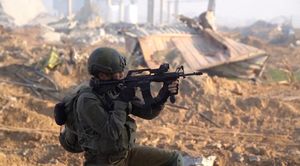Authorities are grappling with the staggering influx of firearms and ammunition flowing from the United States to Latin America and the Caribbean, with dire ramifications for regional security. Recently, U.S.-based airlines reported harrowing experiences of being struck by gunfire when flying over Haiti’s increasingly perilous airspace. This alarming situation points to the broader issue of Haiti's lack of domestic firearm manufacturing capacity. With most of the weapons wreaking havoc likely originating from across the U.S. border, the situation begs for urgent attention.
According to Matt Schroeder, a senior researcher at the Small Arms Survey, traffickers within the U.S. have become major sources of illicit weapons circulating throughout the Caribbean and Latin America. “Available evidence indicates. . . the illicit acquisition and use of firearms pose among the most pressing security threats in the hemisphere,” he stated. This sentiment resonates with many citizens across the region who are increasingly alarmed by rising violence.
A recent report by the Small Arms Survey reveals nearly a staggering 120% surge in firearm shipments seized from the U.S. destined for the Caribbean and Latin America since 2016. Such increases are especially concerning as they only represent the weapons intercepted. This leaves many others trafficked undetected or hidden beneath the surface of countless criminal investigations. While it remains unclear whether this spike reflects improved data collection, heightened traffic enforcement, or true increases in trafficking activities, one constant remains: the persistent demand for illicit firearms cannot be ignored.
With communities dealing with mounting violence, global law enforcement agencies have pointed to the black market for American firearms as a fundamental driver behind humanitarian crises across Mexico, Haiti, and other regions. Reports suggest upwards of one million firearms are smuggled annually over the U.S. border, often including military-grade weapons. For families and communities steeped in uncertainty and fear, these numbers are nothing short of chilling.
Further complicate things, the Government Accountability Office recently reported U.S.-sourced firearms are the roots of considerable violence within Caribbean nations. According to the report, between 2018 and 2023, 73% of firearms recovered from crime scenes across the Caribbean could trace their origins back to the U.S. Many of these weapons were sold from states like Florida, Georgia, and Texas, and they account for 90% of homicides across several vulnerable countries within the region. This clear association between the U.S. gun market and rising crime rates puts heavy pressure on authorities to address the issue.
Schroeder's findings also highlight concerning shifts within the types of firearms being seized. Though firearms destined for Latin America still dominate the statistics, the Caribbean is experiencing alarming growth concerning interceptions of AK- and AR-style rifles, alongside high-capacity magazines. Among the seized rifles headed for the Caribbean, approximately 77% belong to the AK or AR category, contrasting with only 48% for shipments directed toward Mexico.
For the citizens of Caribbean nations, the disturbing prevalence of high-capacity magazines does not simply signify the availability of weapons. Instead, these troubling statistics spark urgent questions surrounding the future safety and stability of communities. Alarmingly, 93% of magazines identified were capable of holding more than ten rounds, raising fears of mass violence.
Investigations continue as data becomes more available, placing both U.S. and international authorities against the clock to prevent the illegal flow of arms from worsening the situation. Local communities are calling for tighter regulations and increased monitoring, hoping collective efforts can stem the tide of violence before it engulfs even more innocent lives.
Families caught up within this turmoil can only sit back, anxiously awaiting the changes they desperately seek before another tragedy strikes close to home. With the world watching closely, the ramifications of this arms crisis reach far beyond borders, impacting countless lives longing for stability and peace.



